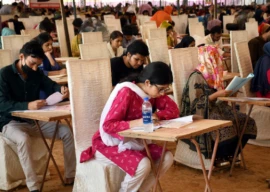
With many residents of the federal capital already intricately familiar with several regions of the neighbouring Khyber-Pakhtunkhwa province, either through travel or business, a large number of people thronged the Lok Mela to visit the tastefully decorated and artistically rich pavilion of the province.
The entrance of the pavilion was built up to replicate the Khyber Pass - which once served as a gateway to the subcontinent - and in many ways it still does.
Organised by the National Institute of Folk and Traditional Heritage (Lok Virsa), the Khyber-Pakhtunkhwa (K-P) pavilion had been set up by the K-P Culture and Tourism Authority (K-PCTA).
The pavilion boasted a host of traditional craft and fare from handicrafts to foodstuff, wildlife, Kalash culture and costumes, music, travel and tourism, and artistic corners.
The visitors showed keen interest in the tourism displays including scenic places, archaeological and heritage sites and cultural and traditional handicrafts.
Amongst the handicrafts, visitors were drawn to Swati Shawls, Kalash embroidery, Taghar work, Royal Khaadi from Bannu, stone carving, Peshawari caps and sandals, metalwork, wood carving from different parts of the province, calligraphy, ring-making, sitars, Chitrali Patti, Gandhara art, Drooza chappal, Sarghashay, Charsadda Khaddar and chappal, maizaray work, Karawa work, Sarkha, Dandas, Parunay, pottery work, blacksmith work, Hazara Jisti Shawl and Moti work and cultural items and jewellery made of copper and stone.
Traditional dances were performed and folk music with rabab mangay played to entertain the visitors and tourists at the expo.
The food of the province was also a major draw including the traditional specialities of ‘chapli’ kabab and qehwas on the cool evenings.
This year, many stalls were allocated to female artisans, which created an inclusive atmosphere. Women artisans include Rameem Naz in crosia/wool work, Ishrat Safdar in shawl weaving, Noshaba Noshad in Haripur phulkari, Munaza Hayat in handmade motifs work, Farah Naz in cross stitch calligraphy work, etc.
Noshad, who specialises in ‘Phulkari’ - the famous form of embroidery of the Hazara region - said that the tradition of embroidery runs in her family. She attained mastery in Phulkari - flower work or flowering on a handwoven coarse cotton cloth - from her mother and other female members of her community at a very tender age.
Noshad explained that in Phulkari, silk threads in yellow, shocking pink, white and green are used and darning stitch is employed in vertical, horizontal and diagonal movements to create elaborated geometric and floral patterns.
There were several male artisans as well including Waseem and Faheem who did lacquer work, Riaz Ahmad who did wax printing, stone carvers Aurangzeb and Abdus Salam, Karakulli cap maker Muhammad Khalil in, wood artist Syed Ahmed Shah, and blacksmith Khawaja Safar.
The entire pavillion though was full of aromas from the food stalls with the smell of hot, fresh `chappal kababs’ lingering in the air.
A performance pit has also been created in the pavilion where musicians from K-P perform Pakhtoon folk music `Tunk Takor’ whilst playing traditional musical instruments such as the rubab, tabla, harmonium, etc.
Published in The Express Tribune, November 11th, 2020.


1735196035-0/beyonce-(7)1735196035-0-165x106.webp)









1735025557-0/Untitled-(96)1735025557-0-270x192.webp)











COMMENTS
Comments are moderated and generally will be posted if they are on-topic and not abusive.
For more information, please see our Comments FAQ